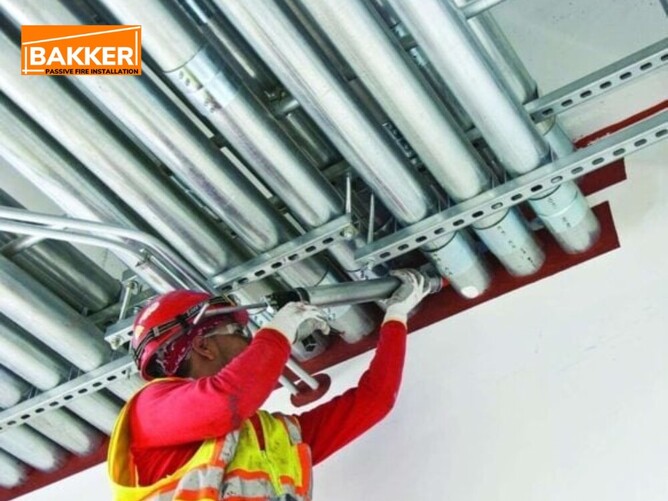Your Guide to Fire-Resistant Buildings
When discussing building safety, passive fire protection (PFP) is a term that stands out in building code documents.
Although it might sound complex, PFP is the unsung hero of fire safety, working quietly behind the scenes to stop fires from spreading.
It’s about using fire-resistant walls, strategically placed fire doors, and other design elements to contain a fire, giving residents extra time to escape and firefighters a chance to control the blaze.
Understanding fire protection ratings is crucial for architects, engineers, and building owners to make informed decisions regarding materials and construction techniques.
These ratings indicate how long a building element can withstand fire exposure while maintaining structural integrity.
Passive Fire Protection: A Deep Dive
Passive fire protection uses building design and materials to limit the spread of fire and smoke.
Unlike active systems like sprinklers and alarms, PFP is always in place, silently doing its job.
If a fire occurs, PFP contains it to its origin point, buying valuable time for evacuation and reducing overall damage.
This makes PFP a critical part of any building’s safety strategy.
Understanding the Importance of Passive Fire Protection
To truly understand the impact of PFP, consider the devastating effects of fire and smoke. The financial damage to property can be significant, but the human cost is far greater.
Smoke inhalation is one of the deadliest aspects of a fire, causing injuries from thermal damage, poisoning by carbon monoxide or cyanide, and severe respiratory problems.
PFP helps create a safer environment by controlling the spread of smoke and fire.
Key Elements of Passive Fire Protection
Fire-Resistant Walls and Floors:
Non-combustible materials used for walls, floors, and doors compartmentalize the building, preventing flames from spreading quickly.
These barriers give occupants crucial extra minutes to evacuate.
Fire Doors:
Designed to withstand intense heat and smoke for specific periods, fire doors play a vital role in containment.
Properly installed and maintained, they can make the difference between a controlled fire and a rapidly spreading one.
Firestopping:
Firestopping seals gaps and penetrations where fire and smoke could spread, such as around pipes, cables, and ducts.
Using fire-resistant materials, firestopping secures the building’s perimeter.
Intumescent Materials:
Intumescent materials expand when exposed to heat, forming tight seals around doors and windows to block out flames and smoke, keeping escape routes clear.
Smoke Control Systems:
Strategically placed smoke barriers and vents help contain smoke within specific areas, improving visibility for evacuating people and aiding in safe evacuation.
Passive Fire Protection in New Zealand
In New Zealand, we take fire safety seriously, and PFP is a vital element within the Building Code. It sets the minimum requirements for fire safety in all new buildings and renovations.
This framework outlines strict standards for fire-resistant construction, compartmentation, and other PFP measures. The goal is to protect lives and minimise the risk of fire-related damage across the country.
For professionals in the industry, especially those involved in design, specification, and installation, The Guide to Passive Fire Protection in Buildings from BRANZ is an excellent resource.
Always make sure you're following the most up-to-date version of the Building Code to stay compliant and keep your buildings safe.
The Importance of Regular Inspections and Maintenance
Having PFP installed is not enough; it must be maintained. Regular inspections are crucial to ensure all elements function correctly.
This includes checking fire-rated doors, firestopping materials, and fire-resistant walls and floors for any damage or deterioration.
Proactive maintenance ensures the long-term effectiveness of your PFP systems.
FAQs about Passive Fire Protection
What is meant by passive fire protection?
Passive fire protection uses building components and design features to limit fire spread.
It requires no activation and works to contain fires, including firewalls, fire-resistant doors, and firestopping.
What is active vs passive fire protection?
Active fire protection includes systems like sprinklers and alarms that detect and react to fire.
Passive fire protection uses fire-resistant walls and doors to contain fires without activation, limiting spread and buying time for evacuation.
What is an example of a passive fire protection plan?
A PFP plan outlines a building's fire safety features, showing the placement of firewalls, fire doors, and firestopping materials to comply with regulations and prevent fire spread.
What is passive fire protection in NZ?
In New Zealand, passive fire protection is governed by the Building Code.
They've got strict guidelines for using fire-resistant materials, firestopping products, and fire-rated doors and windows in buildings to protect people and property.
They take their fire safety seriously
Ben's Wrap
Passive fire protection is the often-invisible shield that makes a world of difference in the crucial first minutes of a fire.
Understanding and implementing PFP elements like fire-resistant walls, doors, and firestopping measures are vital for creating safe environments.
It’s not just about complying with regulations; it’s about ensuring the safety of everyone in the building.
At Bakker PFI, we are dedicated to providing top-tier passive fire protection solutions. Trust us to enhance your building’s safety and compliance.
Contact us today to learn how we can help safeguard your property with our expert services.
